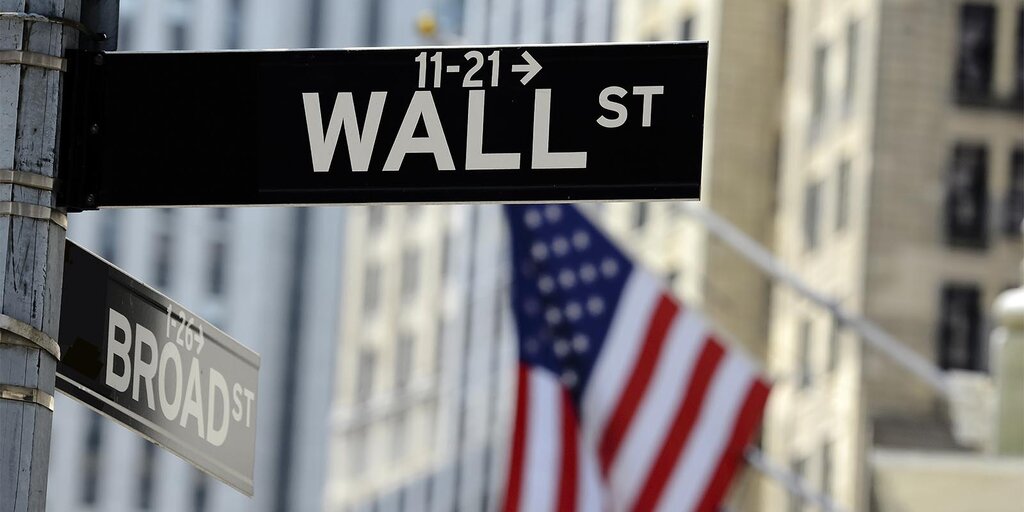Good morning. Here’s what’s happening:
Prices: Crypto markets and other assets liked the sound of a more moderate approach to U.S. monetary policy as Fed Chair Jerome Powell’s suggested that the central bank would boost interest rates by only 50 basis points.
Insights: Blockchain-based enterprise software has not been the success that industries expected.
Prices
870.95
+3.9 ▲ 0.5%
$17,158
+229.6 ▲ 1.4%
$1,290
+18.6 ▲ 1.5%
S&P 500 daily close
4,080.11
+122.5 ▲ 3.1%
Gold
$1,788
+40.0 ▲ 2.3%
Treasury Yield 10 Years
3.7%
▼ 0.0
BTC/ETH prices per CoinDesk Indices; gold is COMEX spot price. Prices as of about 4 p.m. ET
Fed Chair’s Moderate Remarks Send Cryptos Higher
By James Rubin
U.S. central bank Chair Jerome Powell wasn’t exactly dovish in a speech Wednesday, but his suggestion that the Fed could live with a more moderate interest rate hike at its mid-December meeting sent cryptocurrency prices, not to mention other assets higher.
Bitcoin was recently trading over $17,150, up 1.4% over the past 24 hours, and its third consecutive day of gains. The largest cryptocurrency by market capitalization had started surging on Monday amid investor hopefulness that Powell and other Fed officials have found reassurance in economic indicators showing inflation and the threat of a harsh recession waning. BTC sank below $15,500 two weeks ago as markets chewed on Genesis Global Capital’s decision to halt withdrawals, part of the fallout from crypto exchange giant FTX’s implosion.
Bilal Little, president of DFD Partners, told CoinDesk TV’s First Mover Program that this week’s rally also reflected a price reordering that often follows periods of distress. “Anytime you have an episodic event, markets tend to oversell, and what also happens is you see the immediate look to contagion, and everyone starts pointing fingers. Then as markets gain more clarity, you see the fair market value come back into alignment.”
Ether was recently changing hands over $1,290, up 1.5% from Tuesday, same time. Other major altcoins were largely in the green with MATIC, the token of layer 2 scaling tool Polygon, rising more than 5%. Popular meme coin DOGE countered the trend, falling more than 3% after soaring about 50% over the previous eight days. DOGE is trading well over $.10 cents.
Prices moved little late on Wednesday, seemingly unimpressed by former FTX CEO Sam Bankman-Fried’s latest non-confessions in a New York Times live interview about the missteps leading to FTX’s filing for Chapter 11 bankruptcy protection on Nov. 11. Bankman-Fried spoke in generalities, often looking down at the floor as the Times’ uber-reporter Andrew Ross Sorkin peppered him with questions. “I didn’t ever try to commit fraud,” Bankman-Fried said at one point.
Cryptos’ upswing was small compared to equity markets, which soared on Powell’s remarks at the Hutchins Center on Fiscal and Monetary Policy in Washington D.C. that the Fed would likely raise interest rates 50 basis points (BPS) instead of continuing its recent diet of 75 bps increases. Investors were also heartened by the U.S.’s third quarter GDP, which grew 2.9%, up from the Commerce Department’s original 2.6% estimate.
DFD Partners’ Little was pessimistic about crypto prices continuing to climb, saying that bitcoin would likely sink to the $12,000 to $13,000 level before topping $22,000, a level it last reached in October. “It’s going to be on the back of what are the other contagion impacts, around this particular event, FTX” he said. “Different providers are going to struggle to not only meet liquidity demands but also counter-party risk.”
Biggest Gainers
Biggest Losers
Insights
The Failure of Blockchain-Based Enterprise Software
By Sam Reynolds
Rewind to the last crypto bear market, and the narrative of ‘enterprise blockchain’ was driving the recovery. Although this funny internet money was subject to booms and busts, the programmability of blockchain technology was supposed to unlock trillions of dollars of real value. Beijing had identified it as a strategic technology, after all.
But despite the $3.1 trillion in unlocked value that Gartner promised by 2030, industry use cases for blockchain continue to fade away.
Recently, Maersk and IBM announced that TradeLens, the blockchain-based transparent ledger that was supposed to improve freight processing and customs clearance, will be wound down in 2023.
“TradeLens has not reached the level of commercial viability necessary to continue work and meet the financial expectations as an independent business,” Maersk Head of Business Platforms Rotem Hershko said in a statement.
Keyword: commercial viability. This seems to be the theme with enterprise blockchain applications. Executives aren’t able to determine why we need this as opposed to more traditional database technology.
Earlier this month, the Australian Securities Exchange (ASX) said it was canceling a planned blockchain-based upgrade to its clearing house system. The existing system was performing well enough, and executives at the bourse couldn’t justify spending on a system upgrade that might not do much more than its predecessor.
Amazon: Why Blockchain?
Tim Bray, one of the godfathers of web software development, offers an anecdote about all this on his blog. blog.. Until early 2020, Bray was a vice president at Amazon Web Services (AWS) beforeresigning as a high-profile defector, vocally criticizing Amazon for its “vein of toxicity”.
In 2016, assumedly during happier times in his career at the company, Bray was in a meeting with Andy Jassy, the then-CEO of AWS, and the topic was blockchain. Bray writes (the entire post is worth reading) that Jassy was hearing from his clients that AWS needed a blockchain strategy. But Jassy couldn’t understand why blockchain was necessary when existing tools provided sufficient solutions.
AWS was already making a ton of money from blockchain. Many of the world’s crypto exchanges or other infrastructure projects host their products on the platform (see: the $4.6 million AWS bill to Alameda/FTX). But this is different than what the world’s industrial and commercial giants were being told they wanted. They needed to integrate blockchain, investors said, and it was up to AWS to implement this.
“I can’t remember the details of how our findings got back to Andy. They were of the form ‘Ledgers are useful, cryptography tech is useful, blockchains aren’t, the field is full of grifters, but we could build distributed-ledger infrastructure and then these cool services on top of it,’” Bray wrote. “I’m not prepared to say that no blockchain-based system will ever be useful for anything. But I’m gonna stay negative until I see one actually at work doing something useful, without number-go-up greedheads clamped on its teats.”
AWS still has a blockchain segment, and is said to be in the process of preparing to double down on China, the only market where enterprise blockchain continues to exist at scale because of state diktat (where’s the on-chain data?).
Meanwhile, its competitor, Microsoft Azure, has shuttered its cloud blockchain services. As CoinDesk reported last year, IBM’s blockchain division is a “shell of its former self.”
Bray noted in his post that it wasn’t the role of AWS to “ascertain market realities.” They needed to build what the customer wanted. Jaffy, the executive in charge of the division, was “possibly the world’s single most accomplished person at listening to people talk about Enterprise IT problems and the tools needed to fix them,” and if he couldn’t see the value of this technology, it probably wasn’t worth anyone’s time.
But at the time, if you questioned the technology, you were a “peasant,” as Bray noted, because all the ‘Serious Enterprises full of Serious People” were about to adopt blockchain.
And now, those that did are abandoning it.
Let’s just admit that it was all a failure.
Important events.
3:00 p.m. HKT/SGT(7:00 UTC) Germany’s Retail Sales (YoY/Oct)
9:30 p.m. HKT/SGT(13:30 UTC) Bank of Japan Governor Kuroda speech
11:00 p.m. HKT/SGT(15:00 UTC) United States ISM Manufacturing PMI (Nov)
CoinDesk TV
In case you missed it, here is the most recent episode of “First Mover” on CoinDesk TV:
Bitcoin Rises Toward $17K; BlockFi Has $355M in Crypto Frozen on FTX
Crypto lender BlockFi has about $355 million in cryptocurrencies currently frozen on defunct crypto exchange FTX. CoinDesk’s Nikhilesh De discussed the latest developments uncovered during BlockFi’s first day in bankruptcy court. Howard Fischer, former SEC senior trial counsel and current partner at Moses Singer, shared his thoughts on the legal proceedings. Plus, former AAX Vice President Ben Caselin, who has resigned amid the crypto exchange’s withdrawal halt, joined the conversation. And, a crypto markets analysis with Bilal Little of DFD Partners.
Headlines
Telegram CEO Durov Plans to Build Crypto Wallets, Decentralized Exchange: The messaging app is pushing ahead with its buildout of crypto infrastructure.
Bitcoin Correlation With the Dollar Index Turns Negative, Again: Asset managers reduced long positions in BTC for a third consecutive week.
Kraken Cuts 30% of Workforce Amid Crypto Winter: The crypto exchange is laying off 1,100, after saying it was in hiring mode earlier this year.
Near Foundation Joins Processed Foods Giant Grupo Nutresa to Unveil Web3 Loyalty Program in Latin America: It is the first open-source loyalty program using the Near protocol and aims to reach one million consumers throughout the region.
Bitcoin Custody Firm Casa to Add Ethereum Support: The addition is part of a major overhaul of the Casa app, which will be relaunched in January.
Read More: news.google.com









 Bitcoin
Bitcoin  Ethereum
Ethereum  Tether
Tether  XRP
XRP  Solana
Solana  USDC
USDC  Dogecoin
Dogecoin  Cardano
Cardano  TRON
TRON  Lido Staked Ether
Lido Staked Ether  Sui
Sui  Wrapped Bitcoin
Wrapped Bitcoin  Chainlink
Chainlink  Avalanche
Avalanche  Wrapped stETH
Wrapped stETH  Shiba Inu
Shiba Inu  Stellar
Stellar  Pi Network
Pi Network  Hedera
Hedera  Toncoin
Toncoin  Hyperliquid
Hyperliquid  Bitcoin Cash
Bitcoin Cash  USDS
USDS  Polkadot
Polkadot  LEO Token
LEO Token  Litecoin
Litecoin  WETH
WETH  Monero
Monero  Pepe
Pepe  Wrapped eETH
Wrapped eETH  Bitget Token
Bitget Token  Binance Bridged USDT (BNB Smart Chain)
Binance Bridged USDT (BNB Smart Chain)  Coinbase Wrapped BTC
Coinbase Wrapped BTC  Ethena USDe
Ethena USDe  WhiteBIT Coin
WhiteBIT Coin  Uniswap
Uniswap  Bittensor
Bittensor  NEAR Protocol
NEAR Protocol  Aptos
Aptos  Dai
Dai  Ondo
Ondo  Aave
Aave  OKB
OKB  Internet Computer
Internet Computer  Ethereum Classic
Ethereum Classic  BlackRock USD Institutional Digital Liquidity Fund
BlackRock USD Institutional Digital Liquidity Fund  Cronos
Cronos  sUSDS
sUSDS